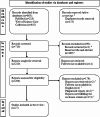Association between dry mouth and dry eyes: a systematic literature review of clinical evidence
- PMID: 40875054
- PMCID: PMC12394332
- DOI: 10.1007/s00296-025-05958-5
Association between dry mouth and dry eyes: a systematic literature review of clinical evidence
Abstract
Sicca syndrome (dry mouth and dry eyes) occurs predominantly due to the side effects of medication, systemic diseases (Sjögren's disease), and radiotherapy of the head and neck region. Sicca complaints decrease the quality of life, cause sleep disturbances, and affect overall health. This systematic literature review investigates the correlation and/or association between dry mouth and dry eyes. A comprehensive search was conducted through PubMed and Web of Science databases up to November 2024. English-language research studies investigating the association and/or correlation between dry mouth and dry eyes were included. Study quality was assessed using NIH quality assessment tools. Data on publication details, participant characteristics, assessment methods, and outcomes was extracted and synthesised based on the type of outcome (objective and/or subjective assessments) and cohort type. Out of 863 records, 27 studies met the eligibility criteria (published 1989-2024), including three observational cohort (n = 942), 15 cross-sectional (n = 6165), and nine case-control (n = 1326 patients, n = 841 controls). 13 studies focused on symptoms in Sjögren's disease, seven in other patient groups, and eight in the general population. Significant correlation and/or association between oral and ocular objective assessments was found in 10 out of 27 studies, and between subjective assessments in 18 out of 19. Within that, 10 out 10 studies assessing self-reported subjective dry mouth and eyes found significant associations. This systematic review provides a general overview of the relationship between dry mouth and dry eyes. It also highlights the need for standardised diagnostic guidelines for dry mouth and dry eyes. PROSPERO registration: CRD42024555796.
Keywords: Dry eye syndromes; Geriatrics; Keratoconjunctivitis sicca; Polypharmacy; Sjögren's syndrome; Xerostomia.
© 2025. The Author(s).
Conflict of interest statement
Declarations. Conflict of interest: The authors declare no conflicts of interest.
Figures
References
-
- Liu B, Dion MR, Jurasic MM, Gibson G, Jones JA (2012) Xerostomia and salivary hypofunction in vulnerable elders: prevalence and etiology. Oral Surg Oral Med Oral Pathol Oral Radiol 114:52–60 - PubMed
-
- Adolfsson A, Lenér F, Marklund B, Mossberg K, Çevik-Aras H (2022) Prevalence of dry mouth in adult patients in primary health care. Acta Odontol Scand 80:605–610 - PubMed
-
- Agostini BA, Cericato GO, ER Silveira da, Nascimento GG, Costa F, dos S, Thomson WM, Demarco FF (2018) How common is dry mouth? Systematic review and meta-regression analysis of prevalence estimates. Braz Dent J 29:606–618 - PubMed
-
- Jamieson LM, Thomson WM (2020) Xerostomia: its prevalence and associations in the adult Australian population. Aust Dent J 65:S67–S70 - PubMed
-
- Stapleton F, Alves M, Bunya VY et al (2017) TFOS DEWS II epidemiology report. Ocul Surf 15:334–365 - PubMed
Publication types
MeSH terms
Grants and funding
LinkOut - more resources
Full Text Sources
Medical
Miscellaneous


